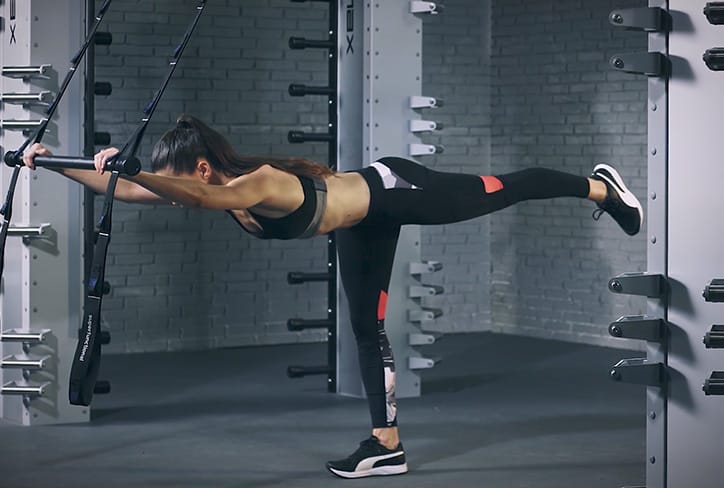How does fitness evolve?
Learn how to perform a hip extension the EVO way. #EVOway #EVOfitness
WHAT
- The hip extension on the trapeze bar is a versatile exercise that can be used as part of a warm up or within a main workout.
- This exercise builds strength, flexibility and balance, and is ideal for those who need extra support before progression to the bodyweight only version.
- The movement focusses on hip and back extension, with shoulder flexion.
- In this version, the trapeze bar provides some support, which will challenge balance whilst promoting alignment.
HOW
- Stand upright and hold the trapeze bar with arms straight. Engage the core and transfer weight to one leg.
- Keeping the support leg straight, hinge at the hips as you reach forwards with the bar. Aim to keep the torso in line with the raised leg.
- Aim to reach a horizontal position, and hold for a few seconds, before slowly returning.
- Alternate between legs and repeat for time or reps.
- As you extend the hip, imagine pushing one leg into the floor and reaching the other leg backwards. Think of the movement as a see-saw – where the upper body is counter-balancing the lower body.
- Training tip – squeeze the shoulder blades and glutes slightly during the movement – this will increase back stability and balance.
WHY
- During this exercise, the entire posterior chain (calves, hamstrings, glutes, back, shoulder) are under tension. The hamstrings (and glutes) of the support leg are being lengthened under tension – creating length and strength, with good postural alignment. This is similar in nature to the tension felt when bending and lifting.
- The ability to extend the hips is an essential skill in daily function and sport. From bending and lifting to running and jumping, it not only moves the hips forward and upwards, it provides a stable base for the spine and shoulder girdle. When hip extension is performed on one leg, there is an increase in torsion through the hip joint and spine, which requires a stabilizing counter-rotation. If this force is not stabilized, it will result in loss of alignment and balance – therefore making this exercise self-correcting. Because the trapeze bar is unstable (but fixed) small self-corrections can take palce without falling over.
- This exercise is a building block for the unsupported version, also known as the Warrior III position in yoga. If Warrior III is too challenging, then the Airplane Pose in yoga (hands to the side) may offer a suitable alternative.
- When performed mindfully and in a controlled manner, this movement is a powerful alternative to traditional stretching, as it will build strength and flexibility, alongside good postural alignment.
Please find here our article about 7 Top Gadgets – Gear and Accessories for Cycling
Do you already know our 7-minute Pilates Workout for Strength



